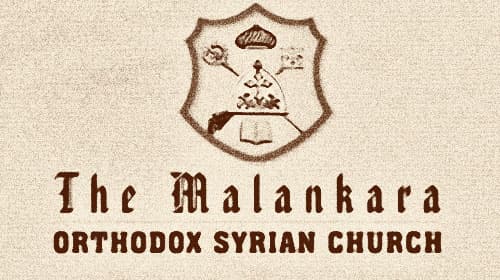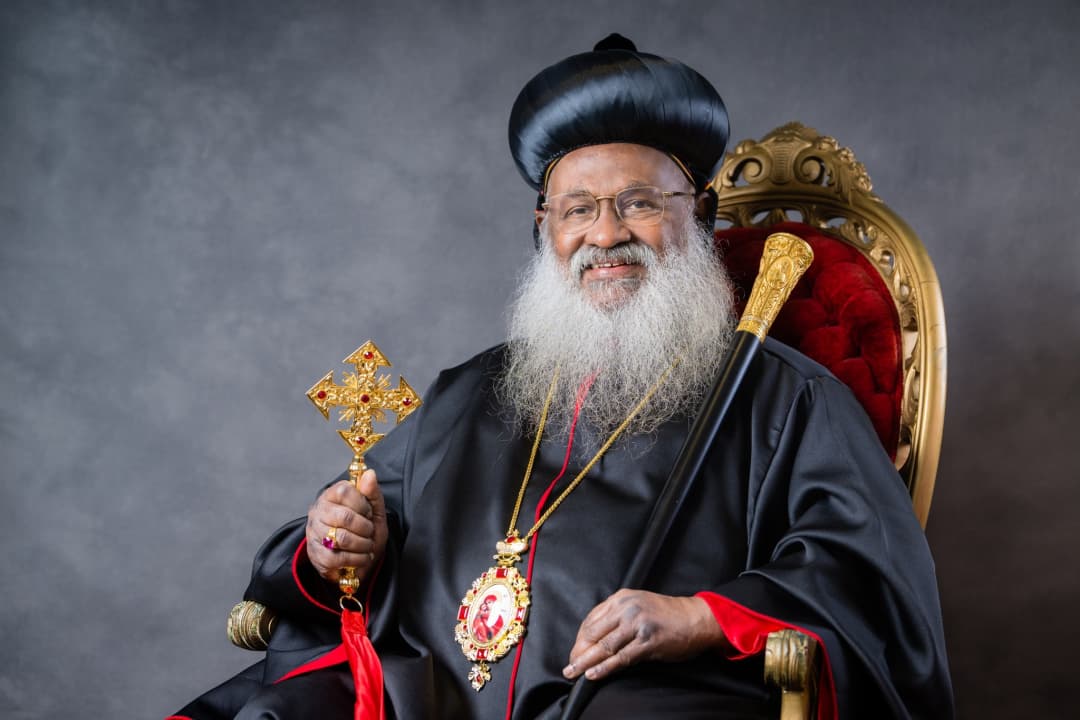Catholicate Of MOSC
The Catholicate of the Malankara Orthodox Syrian Church — the supreme spiritual authority, guiding the faithful in apostolic tradition, heritage, and unity in Christ.
The Catholicate Of Malankara Orthodox Syrian Church
The word 'Catholicos' means “the general head” or “general bishop.” It can be considered as equivalent to “universal bishop.” This title and rank are much more ancient than the title Patriarch in the Church.
In the ministry of the early church there were only three ranks namely; Episcopos (Bishop), Priest and Deacon. By the late third or early fourth century, certain bishops of major cities or provincial capitals in the Roman Empire gained greater authority due to the importance of their regions. These leaders, called Metropolitans, oversaw not only their own dioceses but also surrounding churches. Their role was recognized by the Ecumenical Councils of the fourth century, giving them precedence in matters of faith, discipline, and administration, paving the way for the rise of Patriarchs and Catholicates. This growing structure helped unify the church and strengthen its influence across regions.

By the fifth century, the bishops in major cities like Rome, Constantinople, Alexandria, and Antioch gained control over the churches in the surrounding cities. Gradually, they became the heads of each independent regional church and were called Patriarch, which means “common father.” The same rank in churches outside the Roman Empire was called Catholicos. There were three ancient Catholicates in the Church before the fifth century: the Catholicate of the East (Persia), the Catholicate of Armenia, and the Catholicate of Georgia. None of these ranks or titles are the monopoly of any one church; any Apostolic and national church has the authority to designate its head as Catholicos, Pope, or Patriarch.
Even though the title Catholicos did not exist in India before the 20th century, the concept of the Catholicate or Patriarchate as the head of a national, independent Church had been present from the early centuries, and there was a similar native position of authority in the Indian Church. Just as St. Peter is regarded as the first Pope of Rome, St. Thomas is regarded as the first Head — or the Catholicos — of India.
In India, the position and authority of the Catholicos developed in the history of the Church over the past centuries. The first stage of the apostolic ministry in the Malankara Church extended from the time of St. Thomas until the middle of the fourth century, when the authority of the Church was vested in the Archdeacon.
- The second stage is the period of the reign of the Archdeacons, which began in the middle of the fourth century and lasted until the sixteenth century.
- The third stage began in 1653, when the Archdeacon was elevated by the community to the position of Bishop, taking the name Mar Thoma I.
- Since then, the head of the community was known as the Mar Thoma Metran, and later the position evolved into the Malankara Metropolitan, gaining greater recognition.
During a period of religious turmoil, the Patriarch of Antioch intervened and suspended the Malankara Metropolitan, demanding complete submission. In 1912, the Church responded by consecrating the senior Metropolitan as the Catholicos and head of the Church.
In 1934, at a meeting of the Malankara Association, the authority and powers of the Malankara Metropolitan were entrusted to the Catholicos. Thus, both the spiritual and temporal authorities of the Church were vested in one person — the Catholicos-cum-Malankara Metropolitan — marking the completion of this development in the Church’s leadership structure.
H.H. Baselios Marthoma Mathews III, The Ninth Catholicos of the East in Malankara (2021-Present)

His Holiness Baselios Marthoma Mathews III was formally enthroned as the Catholicos of the East & Malankara Metropolitan on Friday, October 15th, 2021. This esteemed position makes him the Supreme Head of the Malankara Orthodox Syrian Church of India and the 92nd Primate on the Apostolic Throne of St. Thomas.
Born on February 12, 1949, to Mr. Cherian Anthrayos of the Mattathil family, His Holiness is a member of St. Peters Church, Vazhoor. His extensive academic journey began with a B.Sc. in Chemistry from Kerala University. He continued his theological studies at Orthodox Seminary, Kottayam, earning a GST degree, followed by a BD degree from Serampore University.
He pursued higher theological education internationally, studying at the Theological Academy in Leningrad, Russia, and later obtaining his M.Th. and Ph.D. from the prestigious Oriental Institute in Rome .
His ecclesiastical ascent began with his ordination as a Deacon in 1976 and a Priest in 1978 by H.H. Baselios Mathews I. He was consecrated as an Episcopa on April 30, 1991, at Parumala, and elevated to Metropolitan in 1993.
A distinguished educator, His Holiness is a well-regarded faculty member of the Orthodox Seminary, Kottayam, and previously served as the Secretary of the Holy Episcopal Synod . Furthermore, he is a dedicated philanthropist, tirelessly working for the upliftment of the poor, particularly economically backward women, by establishing ventures to provide employment opportunities. He has also authored several devotional and contemplative books in Malayalam.
Historical Development of Catholicate in India
Archdeacons
In India, St. Thomas founded the Church and appointed prelates to continue the apostolic ministry in the Church. It is believed that these prelates were appointed from four ancient families, namely Pakalomattom, Sankarapuri, Kalli, and Kaliankal. Gradually, the Pakalomattom family gained prominence in the ministry, and the chief prelates of the community were hailed from that family. During the reign of Mar Thoma VIII, the Metropolitan of the community in the early 19th century, the Madras Government once asked him for a review of the history of the Malankara Church and gave him seventeen questions to answer. On the 20th of April 1812, he gave written answers to all the questions. The last question was about the position and authority of the Malankara Metropolitan in the Church. In his answer, he said that from 335 AD, for 1,308 years, i.e., until the Coonan Cross Oath, the Church was ruled by the Archdeacons of the Pakalomattom family. He also said that after the coming of the Portuguese, the Church had, besides him, six Metrans and one Metropolitan. The Metran or Malankara Metropolitan of the community was the continuation of the apostolic authority in the Malankara Church. Historical evidence shows that in the early days, the title of the head of the community was Archdeacon. Sometimes the title was known as the Archdeacon of All India. In the native language, it was usually called 'Jathikku Karthavyan'. The Archdeacon of the community was the unquestioned social and political leader and even had local soldiers under his command to protect himself and the interests of the community. The Archdeacon was the unquestioned leader of the community when the Portuguese arrived in Malabar in the 16th century.
The Portuguese tried to bring the Archdeacon under their control. Through the Synod of Udayamperur (1599), they tried their level best to control the Archdeacon, and for a short period, they brought him under the authority of the Roman Archbishop. The community revolted against this through the Coonan Cross Oath of 1653.
The Archdeacon as Bishop
After the Coonan Cross Oath, the Church ordained the Archdeacon as a Bishop with the name Mar Thoma I. This ordination of the Archdeacon as a Bishop was a very important turning point in the history of the development of authority in the Malankara Church. All the powers of the centuries-old Archdeacon, along with additional spiritual authority, were given to the Archdeacon when he was elevated to the position of Bishop.
The Mar Thoma Metrans continued in succession until the early 19th century with the names Mar Thoma I, II, etc., up to Mar Thoma VIII, and they ruled the Church from 1653 to 1816. The spiritual as well as the administrative authority of the community were vested in the Mar Thoma Metrans during this period.
Malankara Metropolitan
In 1816, Pulikottil Joseph Mar Dionysius became a Bishop and received an approval letter, known as the Royal Proclamation, from the Travancore Government to function as the Metropolitan of the community. From then onwards, the head of the Church came to be known as the Malankara Metropolitan. The position of the Malankara Metropolitan in the 19th century was a development from the position of the Mar Thoma Metrans. The power and authority of the Malankara Metropolitan gained more recognition than those of the Archdeacons and Mar Thoma Metrans because of political changes in the country following the establishment of British rule.
From 1816, Dionysius II, Dionysius III, Dionysius IV, Mar Athanasios, and Dionysius V were the Malankara Metropolitans in the 19th century. Among these, Mar Athanasios and Mar Dionysius V exercised enormous spiritual as well as temporal powers inside and outside the community. Mar Dionysius V was the Malankara Metropolitan at the time of the Synod of Mulanthuruthy (1876). During the latter half of the 19th century, there occurred a split in the community due to the work of CMS missionaries and the reformation they supported. This invited closer interference from the Patriarch of Antioch.
To overcome the difficulties caused by the reformation and to support Mar Dionysius V against the reformers, the Church invited the Patriarch to come to India. Patriarch Peter III of Antioch arrived in 1875. Instead of healing the division in the community, the Patriarch tried to use the situation to establish his authority in the Church by suppressing the authority of the Malankara Metropolitan.
He strongly supported Mar Dionysius and called the Synod of Mulanthuruthy.
The Patriarch presided over the Synod, directed its proceedings, and took decisions justifying the actions of the Patriarch in the Malankara Church. After the Synod, he divided the Church into seven dioceses and consecrated six new Bishops to rule each diocese. Through these actions, the Patriarch sought to reduce the authority of the Malankara Metropolitan.
The Way to Catholicate
After the Synod of Mulanthuruthy, the Church became more conscious of establishing a Catholicate (Maphrianate) in the Malankara Church, mainly to avoid unnecessary interference from the Patriarch of Antioch in its internal affairs.
The Patriarch himself directed the Synod of Mulanthuruthy and gained more powers through its decisions. He claimed to be the spiritual and temporal head of the Church. The Malankara Church, which was in dire need of the Patriarch’s support against the reformers, yielded to all the Patriarch's demands. The legal battles against the reformers ended with the final judgment of the Travancore Royal Court in 1889.
The Royal Court judgment was a success for both the Patriarch and Mar Dionysius V in various aspects. The Court declared that the Patriarch held spiritual supervisory powers over the Malankara Church but no temporal authority. The Patriarch was dissatisfied with this decision.
The Patriarch used all possible means to establish both his spiritual and temporal authority in the Church.
Mar Dionysius V died in 1909, and Mar Dionysius VI became the Malankara Metropolitan.
When Mar Dionysius VI assumed the position, the Patriarch demanded a registered deed from him declaring complete allegiance to the Patriarch. Mar Dionysius firmly refused to yield to these demands.
On 31st May 1911, the Patriarch excommunicated Mar Dionysius VI. This excommunication created significant confusion and division in the Malankara Church. Most influential lay leaders and many clergy in the Church supported Mar Dionysius and stood firmly with him.
The Malankara Metropolitan had been the supreme authority in the Church throughout history, and the Patriarchs had always tried, by all possible means, to remove that position from the Church. The Church clearly understood the Patriarch’s intentions when he excommunicated Mar Dionysius VI.
The Consecration of the Catholicos
When the Patriarch excommunicated Mar Dionysius VI, there were two Patriarchs of Antioch: one was Abdulla, who had powers according to the legal documents known as the Firman of the Turkish Government, and the other was Abdedmassiah, who was senior but inactive in Turkey since the government had withdrawn his Firman.
Abdulla was the one who excommunicated the Malankara Metropolitan Mar Dionysius. The Malankara Church contacted Abdedmassiah and invited him to Malankara. The Patriarch came and presided over the meetings of the Episcopal Synod of the Malankara Church, which decided to consecrate a Catholicos for the Malankara Church. Mar Ivanios Metropolitan of the Kandanadu Diocese was unanimously proposed for the post of Catholicos.
On 15th September 1912, at St. Mary’s Church, founded by St. Thomas in Niranam, Mar Ivanios Metropolitan was consecrated with the name Mar Baselios Paulose I as the first Catholicos of the Malankara Church. The chief celebrant of the consecration ceremony was Patriarch Mar Abdedmassiah himself. After the consecration, the Patriarch issued two Kalpanas declaring the importance, privileges, powers, and functions of the Catholicos.
All the authorities and privileges enjoyed by the Patriarch in the Church as its head were also granted to the Catholicos.
By the consecration of the Catholicos, the Indian Church asserted and declared its full autonomy and became a fully autocephalous (self-headed) Church.
After the demise of Catholicos Baselios Paulose I, the Bishops in Malankara, together with Mar Dionysius VI, consecrated Mar Philoxenos of Vakathanam as the second Catholicos with the name Baselios Geevarghese I. When he died in 1928, Mar Gregorios was elected as his successor. He was consecrated by the Indian Bishops on 13th February 1929 with the title Baselios Geevarghese II.
The Patriarchal group questioned the validity of the Catholicate in law courts, and the litigation continued up to the Supreme Court. On 12th September 1958, the constitutional bench of the Supreme Court of India recognized the validity of the Catholicate and unanimously declared that the Patriarch of Antioch has no authority over the Malankara Church and that the Indian Church is completely free under the Catholicos of the East. The judgment also made it clear that all parishes and properties of the Malankara Church are under the authority of the Catholicos.
Moved by the Supreme Court’s final judgment, the Patriarch's group unanimously recommended to Patriarch Ignatius Yacob III to accept the Catholicos as the head of the Indian Church. In December 1958, the Patriarch and the Catholicos agreed to abide by the constitution of the Malankara Church and accepted each other by exchanging letters.
The peace in the Indian Orthodox Church, which began with this mutual acceptance, continued without major issues until the demise of Catholicos Geevarghese II in 1964. The Malankara Association (the representative body of the Church) elected Mar Augen Thimothios as the next Catholicos. According to the constitution of the Church, the Syrian Patriarch, who was on friendly terms with the Malankara Church, was officially invited to participate in the consecration of the Catholicos. The Patriarch accepted the invitation and co-operated with the Malankara Synod in the consecration ceremony.
In all Churches, the position of Patriarch or Catholicos has developed as part of their history. In Rome, Alexandria, Antioch, Constantinople, and the Persian Church, it reached full development and recognition in the 4th century itself. Jerusalem became a Patriarchate at the Council of Chalcedon in 451. The Georgian and Armenian Catholicosates also developed in the same period.
The Patriarchate developed in the Russian Orthodox Church between 1448 and 1589. In Romania, it was established in 1885; in Serbia, in 1879; in Bulgaria, in 1883; and in Ethiopia, only in 1958. In the Malankara Orthodox Church, it was established in 1912.
The Catholicate in India was the result of centuries of growth and development within the Malankara Church. Of course, developments in other Churches, such as Persia, Antioch, and Rome, along with external interferences, influenced its growth at different stages.
It should always be considered a symbol of Apostolic origin, authority, and heritage, as well as the nationality and independence of the Malankara Orthodox Church. Throughout the centuries, the Metropolitan heads of the Thomas Christians were known as the apostolic successors of St. Thomas, the founder of the Indian Church. The Vatican Syriac Codex 22, written in 1301 at Kodungalloor, refers to the Metropolitan of the Church as “The Metropolitan Bishop of the See of St. Thomas, and of the whole Church of Christians in India.” The Church has always asserted that St. Thomas had his apostolic throne in India just as St. Peter had his in Rome or Antioch. When the Catholicate was established, the Catholicos, as the head of the Malankara Church, took the title “The Successor of the Apostolic Throne of St. Thomas.”
